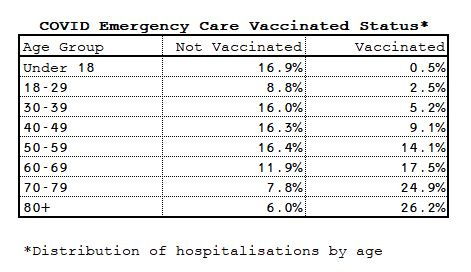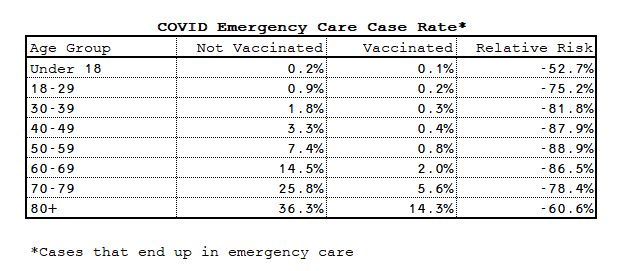Interpreting the weekly COVID Vaccine Surveillance Reports - Part II: Emergency Care
Context matters
Many a breakfast TV presenter or BBC Radio DJ has made a fool of themselves by quoting out-of-date headlines from the UK HSA Weekly Vaccine Surveillance Reports1.
But even if you keep up-to-date with the report, it is still easy to draw wrong conclusions if you are narrow-minded or perhaps suffering from some cognitive bias.
I’m going to try and interpret the latest report being mindful of some statistical pitfalls to try and avoid. I’m going to focus on hospitalisations because I said I would do so as a follow up to this post:
Context
Much of the misleading reporting on COVID has been simply due to lack of context. The relentless focus on nothing but COVID means the general public lacks the proper context in which to assimilate the information they are given.
So, let’s put COVID hospitalisation into context.
Much like the spurious reporting on vaccine effectiveness, it is easy to fall into the trap of confusing absolute risk reduction and relative risk reduction. When the number of beds in English hospitals not occupied by patients with COVID is already 95%, any benefit of COVID vaccination reducing COVID hospitalisations isn’t going to make much difference to overall capacity, is it? That much ought to be pretty obvious to those with no statistical expertise whatsoever… but only if they were given that context.
Perspective
The second way the stats can mislead is because they are not given in the correct perspective. Interestingly, the UK HSA are keen to point out that the majority of cases, hospitalisations and deaths would be in the vaccinated if the majority are vaccinated and the vaccine is not 100% effective. Well, that much we know to be true!
But the same caveat applies when you aggregate across ages, including the youngest age group where the majority is unvaccinated.
We can illustrate this by comparing the age distributions of unvaccinated and vaccinated hospitalisations.
Evidently the distributions are very different. The vaccinated are heavily skewed to the older ages and the opposite is true of the unvaccinated, potentially indicating the “healthy vaccinee” or more accurately, the “unhealthy unvaccinated” effect.
Nevertheless, if we set aside that confounder for the moment and take the relative risk at face value, this is what we get for cases that end up in hospital.
It looks pretty impressive on a relative risk basis but remember context! In absolute terms, the relative risk reduction across the board looks like this in terms of how many unvaccinated might not have ended up in hospital if they had been vaccinated.
And in terms of COVID bed occupancy, we go from 95% not occupied with COVID to 99%.
So, there we have it. With a better understanding and appreciation of context and perspective, the potential for the COVID vaccine to “save the NHS” is really the difference between 99% of hospital beds not being occupied by patients with COVID instead of 95%.
You see the difference in that as a headline instead of:
37% of patients in hospital with COVID are unvaccinated
Never mind 95%, wherever that nonsensical figure came from!
In parting, we must also not forget the other implication of context. 89% of beds are not occupied with COVID. Of those, do we know how many are occupied by those who have suffered an adverse reaction to the vaccine?
We know from the Yellow Card Reporting System that there are thousands of such injuries, over 18,000 new reports in fact covering the period of the latest Vaccine Surveillance report2.
How many of these ended up in hospital? What is the under-reporting rate for vaccine injury?
These things must also be considered but unfortunately, because they are not “COVID”, or worse still, because they are “vaccine”, this data simply isn’t made available for analysis.
You have to wonder how this is possible given that the mRNA therapy only has Emergency Use Authorisation, i.e. those who have taken it are literally taking part in the biggest medical experiment in history, and proper records aren’t even being kept?
The best we have is the periodic ONS reports on deaths by vaccination status. If my re-examination of that report is anything to go by, I think the best we could hope for is that the hospitalisations caused by the vaccine are no higher than the COVID hospitalisations they mitigate, nothing more than that3.
https://www.gov.uk/government/publications/covid-19-vaccine-weekly-surveillance-reports
https://yellowcard.ukcolumn.org/yellow-card-reports







